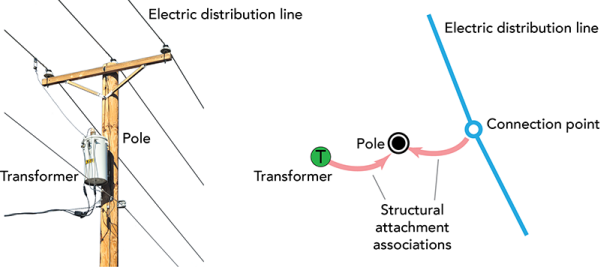When a utility network is created, a common domain network named the structure network is included to be shared across different domain networks. Utilities commonly carry more than one type of resource on a common set of structures. For example, a pole may support electric lines, telecommunication wires, and cable lines. Similarly, a duct bank may carry many types of utility resources. Sharing a structure network among multiple domain networks eliminates redundancy and allows you to better track joint usage on poles and ducts.
A structure network does not have any resources (such as water or electricity) flowing through it; however, the structure network can contain other features that are part of the resource-delivering network. For example, a vault (which is a structure) can contain valves and regulators (part of the active network).

The illustration above shows conceptually how a transformer is attached to a pole, as well as a connection point on the electric distribution line.
One key purpose of a structure network is to support a type of association called structural attachments. Structural attachments provide an efficient method to create a list of structures that are supporting a section or subnetwork. This satisfies a utility's need to rapidly identify which structure, such as a pole, is associated with a device that may be experiencing an outage. Features in the structure network can also act as containers for other network features. For example, a substation can contain other features such as junction boxes, devices, wires, and conductors. This allows a dense collection of features to be represented by a single feature.
Classes in a structure network
The structure network consists of three feature classes and two tables: StructureJunction, StructureLine, StructureBoundary, StructureJunctionObject, and StructureEdgeObject. These classes are created with system-provided attribute domains assigned to system fields for use by the utility network and require additional configuration for use.

The three feature classes are more fully described as follows:
- StructureJunction—Represents structural point features such as poles, pads, vaults, and cabinets that support other features. These are compact features that are tracked in a utility's asset inventory system.
- StructureLine—Represents linear features such as trenches and duct banks. Structure lines contain other network features carrying a resource such as electricity.
- StructureBoundary—Represents polygon container features that contain other network features. For example, a structure boundary can represent the outline of a substation.
The two tables are described as follows:
- StructureJunctionObject—Represents junction objects such as racks or ports.
- StructureEdgeObject—Represents edge objects such as a trench or duct bank.
Structure network attributes
All classes in a structure network share the following attributes:
| Field name | Field alias | Description |
|---|---|---|
| ASSETGROUP | Asset group | Subtype field with the major classification of feature types. |
| ASSETTYPE | Asset type | Field with minor classifications implemented as attribute domains for each asset group type. |
| ASSOCIATIONSTATUS | Association status | Describes the type of association in which a feature participates, the role it plays in the relationship, and visibility properties for content features. For more information, see Association status attribute. |
| SUBNETWORKNAME | Supported subnetwork name | Name of the subnetwork in which the feature resides. Note:The field alias is set to Supported subnetwork name for utility networks created using Utility Network Version 4 and later. Utility networks that are upgraded from version 3 or earlier will have an alias of Subnetwork name. |